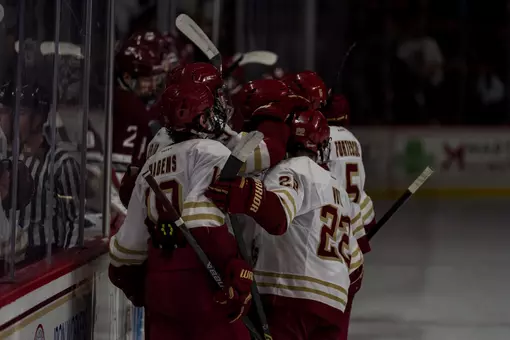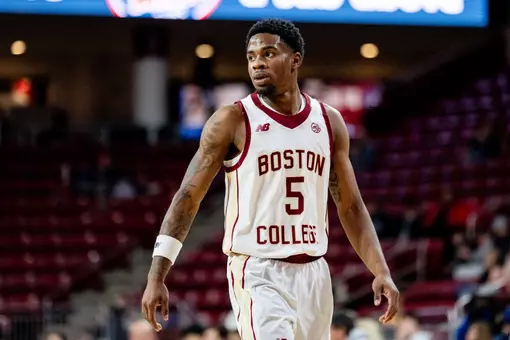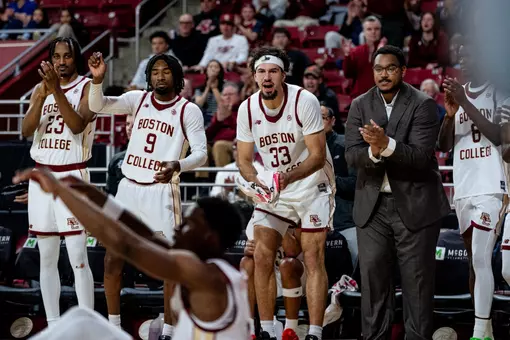
Photo by: Joe Sullivan
Adapting To A Whole New World
October 03, 2024 | Football, #ForBoston Files
Positions are almost irrelevant within a BC scheme built around versatility.
Virginia defensive ends coach Chris Slade is a name familiar to New England football fans who remember their 1996 AFC champions. A former second round pick, the 31st overall selection in the 1993 NFL Draft placed him on the team's defense for virtually the entire decade ahead of his one-year stint with the Carolina Panthers, but the years spent at Foxboro Stadium established him as a member of the franchise's All-Decade Team of the 1990s pick, while simultaneously revitalizing a team once expected to move to St. Louis.
His role as a tackle machine felt simplified to those of us who grew up playing John Madden Football on the Sega Genesis, but pairing him opposite Willie McGinest taught a significant number of New England football fans about base defensive alignments. It was a sign of the times, but roles within a traditional 4-3 or 3-4 base were easy to identify by a position. Nothing varied, which meant defensive backs covered wide receivers, defense linemen rushed the backfield, and linebackers helped either stuff the run or blitz the pocket-passing quarterback.
Those traditional defenses, though, are now being rendered obsolete by more varied offenses utilizing unorthodox formations. Football is no longer built around the smash-mouth style of years past, and even on programs identified as run-first or heavy-set teams, adapting to new styles is paramount to success against defenses unafraid to blend players into different and disguised roles.
"The versatility and the way that coaches have been able to adapt to the versatility of their players [plays a big role]," said Boston College head coach Bill O'Brien. "The most important thing about it is the players. [You can ask] about a skill set, but your ability to evaluate a player and use a player the right way is so important as a coach. It's huge."
College football often discusses BC in the most traditional terms possible because of core elements remaining constant through the program's different eras. For decades, the tough and rugged Northeast program churned and developed strong offensive linemen and bruising running backs that battered and beat down opposing defenses. Quarterbacks limited passing attempts to the necessary throws, but the ability to flip the field for opportunistic points rested more heavily on blue-collar mentalities and an equally physical defense.
The NFL Draft ultimately reflected this ideal, and BC never turned a shy eye to a history that produced more power position selections. The dozen-plus offensive linemen to matriculate into the draft since the turn of the century more than dwarfs the the seven wide receivers picked through the program's overall history, and players who historically dig dirty jerseys into muddy ground - defensive linemen, linebackers, backs and safeties - remain the hallmark staple through even the 2023 first round selection of Zay Flowers.
Yet the idea that BC is nothing more than a smash-mouth football team built around granite blockers overlooks exactly how the Eagles adapted to the modern era, and its defense is perhaps the best exhibit for identifying just how deep those changes reach. In last week's game against Western Kentucky, a linebacker that broke up a pass against Florida State hurried quarterback Caden Veltkamp, and a safety with an interception and forced fumble against Michigan State shifted into the slot to play off the edge in disguised coverage behind defensive ends Neto Okpala and Donovan Ezeiruaku.
"It's the athleticism of the game," said O'Brien. "So much has changed over time that you have guys on our team like Carter Davis, who can play corner or safety. Guys like Kamari Morales can play tight end and fullback. Reed Harris is a tight end and a receiver. It's really the versatility of the game and the way schemes have changed over time, especially in college with more of the spread
"But the best example is now that you've got guys [to counter that] that can play linebacker but also be defensive ends," he explained. "We can use Bam Crouch in different ways. Donovan Ezeiruaku plays at the second level sometimes, and then he plays off the edge. He plays inside and outside."
Ezeiruaku played stand-up defensive end on his strip-sack that forced the game-changing fumble in the fourth quarter, but his ability to fade into coverage produced three defended passes over the past three years. He hurried quarterbacks despite not sacking them for the large portion of last year, but it's what he's doing this year that causes complete carnage for an opposing offense.
"The hardest part about Donovan is what he does pre-snap," said tight end Jeremiah Franklin, "He's so smart, he knows what you're going to do on every down. You call out your play, and you just think to yourself that he knows what you're about to do. You're not going to trick him, and then he's so explosive and strong at that point, with great instincts, that you have to trust your technique."
"And you know," he laughed, "you have to hope help is coming, too."
Like Ezeiruaku and the defense, Franklin's ability to melt into a blocking scheme opens options within the BC scheme. Learning from offensive line coach Matt Applebaum turned him into a movable blocker where the five offensive linemen remain stationary, and the shifting and moving ahead of a snap count is often where his vision and game study takes over. Being afforded that freedom is 100 percent earned in the sense that no player can simply freestyle on the field, but every player is taught the ability to do more with their skills to better the team.
"We work with all of our coaches, not just our position," admitted Franklin. "Everybody helps us come together, and with blocking, it makes me [something more than] a one-trick pony. Throughout the whole offseason, they really helped me bring it in [with the line], and they had me get my hand in the dirt against Donovan, Neto, Quintayvious [Hutchins], all these really tough guys who tried to make me rock solid."
BC is far from the only team utilizing hybrid players on the field, but Virginia is a team with several different unorthodox players baked into its system. Head coach Tony Elliott is a former offensive coordinator at Clemson from a time when the Tigers adopted a spread around quarterbacks, and his ability to create misdirections within the scheme is the perfect complement to defensive coordinator John Rudzinski from his years at Air Force.
"It all just comes down to watching film, studying, and getting prepared for the looks," said Franklin. "You need to know your assignment and the whole scheme. You can't just be glued into what you're doing because if it doesn't go your way, you have to know every key detail on everything. This way, I can help a guy before going to my guy get away with selling one way while attacking or leveraging harder to break into a different [playcall]. It's just about watching more film, and that's what our coaches preach."
Boston College and Virginia meet on Saturday from Scott Stadium in Charlottesville, Virginia. The game can be seen at 12 p.m. on the ACC Network with online streaming available through the ESPN family of Internet and mobile device apps.
His role as a tackle machine felt simplified to those of us who grew up playing John Madden Football on the Sega Genesis, but pairing him opposite Willie McGinest taught a significant number of New England football fans about base defensive alignments. It was a sign of the times, but roles within a traditional 4-3 or 3-4 base were easy to identify by a position. Nothing varied, which meant defensive backs covered wide receivers, defense linemen rushed the backfield, and linebackers helped either stuff the run or blitz the pocket-passing quarterback.
Those traditional defenses, though, are now being rendered obsolete by more varied offenses utilizing unorthodox formations. Football is no longer built around the smash-mouth style of years past, and even on programs identified as run-first or heavy-set teams, adapting to new styles is paramount to success against defenses unafraid to blend players into different and disguised roles.
"The versatility and the way that coaches have been able to adapt to the versatility of their players [plays a big role]," said Boston College head coach Bill O'Brien. "The most important thing about it is the players. [You can ask] about a skill set, but your ability to evaluate a player and use a player the right way is so important as a coach. It's huge."
College football often discusses BC in the most traditional terms possible because of core elements remaining constant through the program's different eras. For decades, the tough and rugged Northeast program churned and developed strong offensive linemen and bruising running backs that battered and beat down opposing defenses. Quarterbacks limited passing attempts to the necessary throws, but the ability to flip the field for opportunistic points rested more heavily on blue-collar mentalities and an equally physical defense.
The NFL Draft ultimately reflected this ideal, and BC never turned a shy eye to a history that produced more power position selections. The dozen-plus offensive linemen to matriculate into the draft since the turn of the century more than dwarfs the the seven wide receivers picked through the program's overall history, and players who historically dig dirty jerseys into muddy ground - defensive linemen, linebackers, backs and safeties - remain the hallmark staple through even the 2023 first round selection of Zay Flowers.
Yet the idea that BC is nothing more than a smash-mouth football team built around granite blockers overlooks exactly how the Eagles adapted to the modern era, and its defense is perhaps the best exhibit for identifying just how deep those changes reach. In last week's game against Western Kentucky, a linebacker that broke up a pass against Florida State hurried quarterback Caden Veltkamp, and a safety with an interception and forced fumble against Michigan State shifted into the slot to play off the edge in disguised coverage behind defensive ends Neto Okpala and Donovan Ezeiruaku.
"It's the athleticism of the game," said O'Brien. "So much has changed over time that you have guys on our team like Carter Davis, who can play corner or safety. Guys like Kamari Morales can play tight end and fullback. Reed Harris is a tight end and a receiver. It's really the versatility of the game and the way schemes have changed over time, especially in college with more of the spread
"But the best example is now that you've got guys [to counter that] that can play linebacker but also be defensive ends," he explained. "We can use Bam Crouch in different ways. Donovan Ezeiruaku plays at the second level sometimes, and then he plays off the edge. He plays inside and outside."
Ezeiruaku played stand-up defensive end on his strip-sack that forced the game-changing fumble in the fourth quarter, but his ability to fade into coverage produced three defended passes over the past three years. He hurried quarterbacks despite not sacking them for the large portion of last year, but it's what he's doing this year that causes complete carnage for an opposing offense.
"The hardest part about Donovan is what he does pre-snap," said tight end Jeremiah Franklin, "He's so smart, he knows what you're going to do on every down. You call out your play, and you just think to yourself that he knows what you're about to do. You're not going to trick him, and then he's so explosive and strong at that point, with great instincts, that you have to trust your technique."
"And you know," he laughed, "you have to hope help is coming, too."
Like Ezeiruaku and the defense, Franklin's ability to melt into a blocking scheme opens options within the BC scheme. Learning from offensive line coach Matt Applebaum turned him into a movable blocker where the five offensive linemen remain stationary, and the shifting and moving ahead of a snap count is often where his vision and game study takes over. Being afforded that freedom is 100 percent earned in the sense that no player can simply freestyle on the field, but every player is taught the ability to do more with their skills to better the team.
"We work with all of our coaches, not just our position," admitted Franklin. "Everybody helps us come together, and with blocking, it makes me [something more than] a one-trick pony. Throughout the whole offseason, they really helped me bring it in [with the line], and they had me get my hand in the dirt against Donovan, Neto, Quintayvious [Hutchins], all these really tough guys who tried to make me rock solid."
BC is far from the only team utilizing hybrid players on the field, but Virginia is a team with several different unorthodox players baked into its system. Head coach Tony Elliott is a former offensive coordinator at Clemson from a time when the Tigers adopted a spread around quarterbacks, and his ability to create misdirections within the scheme is the perfect complement to defensive coordinator John Rudzinski from his years at Air Force.
"It all just comes down to watching film, studying, and getting prepared for the looks," said Franklin. "You need to know your assignment and the whole scheme. You can't just be glued into what you're doing because if it doesn't go your way, you have to know every key detail on everything. This way, I can help a guy before going to my guy get away with selling one way while attacking or leveraging harder to break into a different [playcall]. It's just about watching more film, and that's what our coaches preach."
Boston College and Virginia meet on Saturday from Scott Stadium in Charlottesville, Virginia. The game can be seen at 12 p.m. on the ACC Network with online streaming available through the ESPN family of Internet and mobile device apps.
Players Mentioned
Men’s Hockey: Maine Press Conference (Nov. 21, 2025)
Saturday, November 22
Men's Basketball: Davidson Press Conference (Nov. 21, 2025)
Friday, November 21
From the Desk of Blake James: Episode 4
Friday, November 21
Women's Basketball: Harvard Postgame Press Conference (Nov. 19, 2025)
Thursday, November 20
























